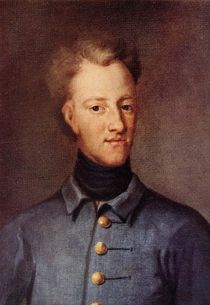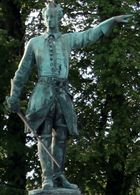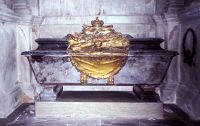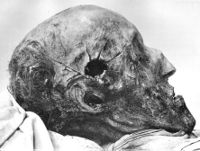Charles XII of Sweden
| Charles XII | |
|---|---|
| King of Sweden Duke of Bremen and Prince of Verden Duke of Palatinate-Zweibrücken |
|
 |
|
| Charles XII in military uniform, David von Krafft (1706) | |
|
|
|
| Reign | 5 April 1697 – 30 November 1718 (21 years, 239 days) |
| Coronation | 14 December 1697 (aged 15) |
| Predecessor | Charles XI |
| Successor | Ulrika Eleonora |
| House | House of Pfalz-Zweibrücken |
| Father | Charles XI of Sweden |
| Mother | Ulrike Eleonora of Denmark |
| Born | 17 June 1682 Tre Kronor (castle), Sweden |
| Died | 30 November 1718 (aged 36) Fredrikshald, Norway |
| Burial | 26 February 1719 Riddarholmen Church, Stockholm |
| Signature | |
Charles XII also Carl, Swedish: Karl XII, Latinized to Carolus Rex, Turkish: Demirbaş Şarl, also known as Charles the Habitué (17 June 1682 – 30 November 1718) was the King of Sweden from 1697 to 1718.
Charles was the only surviving son of King Charles XI of Sweden and Ulrika Eleonora the Elder, and he assumed the crown at the age of fifteen, at the death of his father.
He left the country three years later to embark on a series of battles overseas. These battles were part of the Great Northern War, fought against Russia, Saxony and Denmark-Norway, countries that had joined in a coalition to attack Sweden.
Charles XII was a skilled military leader and tactician. However, although he was also skilled as a politician, he was reluctant in making peace. Charles is quoted by Voltaire as saying upon the outbreak of the Great Northern War, "I have resolved never to start an unjust war but never to end a legitimate one except by defeating my enemies." Although Sweden achieved several large scale military successes early on, and won the most battles, the Great Northern War eventually ended in Sweden's defeat and the end of the Swedish Empire.
Contents |
Royal title
Charles, like all kings, was styled by a royal title, which collected all his titles into one single phrase. This was:
We Charles, by the Grace of God King of Sweden, the Goths and the Vends, Grand Duke of Finland, Duke of Estonia and Karelia, Lord of Ingria, Duke of Bremen, Verden and Pommerania, Prince of Rügen and Lord of Wismar, and also Count Palatine by the Rhine, Duke of Bavaria, Count of Zweibrücken-Kleeburg, as well as Duke of Jülich, Cleve and Berg, Count of Veldenz, Spanheim and Ravensberg and Lord of Ravenstein.
The fact that Charles was crowned as Charles XII does not mean that he was the 12th king of Sweden by that name. Swedish kings Erik XIV (1560–1568) and Charles IX (1604–1611) gave themselves numerals after studying a mythological history of Sweden. He was actually the 6th King Charles.[1] The non-mathematic numbering tradition continues with the current King of Sweden, Carl XVI Gustaf, being counted as the equivalent of Charles XVI.
Early campaigns

In 1700, Denmark-Norway, Saxony, and Russia united in an alliance against Sweden, using the perceived opportunity as Sweden was ruled by the young and inexperienced King. Early that year, all three countries declared war against Sweden. Charles had to deal with these threats one by one.
Charles's first campaign was against Denmark-Norway, ruled by his cousin Frederick IV of Denmark, which threatened a Swedish ally, Charles' brother-in-law Frederick IV of Holstein-Gottorp. For this campaign Charles secured the support of England and the Netherlands, both maritime powers concerned about Denmark's threats to close the Sound. Leading a force of 8,000 and 43 ships in an invasion of Zealand, Charles rapidly compelled the Danes to submit to the Peace of Travendal in August 1700, which indemnified Holstein.
Having defeated Denmark-Norway, King Charles turned his attention upon the two other powerful neighbors, King August II of Poland (cousin to both Charles XII and Frederick IV of Denmark-Norway) and Peter the Great of Russia, who also had entered the war against him, ironically on the same day that Denmark came to terms.
Russia had opened their part of the war by invading the Swedish-held territories of Livonia and Estonia. Charles countered this by attacking the Russian besiegers at the Battle of Narva. The Swedish army of ten thousand men was outnumbered four to one by the Russians. Charles attacked under cover of a blizzard, effectively split the Russian army in two and won the battle. Many of Peter's troops that fled the battlefield drowned in the Narva River, and the total number of Russian fatalities reached about 17,000 at the end of the battle, while the Swedish troop lost 667 men.
Charles did not pursue the Russian army. Instead, he turned against Poland-Lithuania, which was formally neutral at this point, thereby disregarding Polish negotiation proposals supported by the Swedish parliament. Charles defeated the Polish king Augustus II and his Saxon allies at the Battle of Kliszow in 1702 and captured many cities of the Commonwealth. After the deposition of the king of the Polish-Lithuanian Commonwealth, Charles XII put Stanisław Leszczyński on the throne.
Russian resurgence
While Charles won several battles in the Commonwealth, the Russian Tsar Peter the Great embarked on a military reform plan that improved the Russian army. Russian forces managed to retake Ingria and established a new city, Saint Petersburg, there. This prompted Charles to attack the Russian heartland with an assault on Moscow, allying himself with Ivan Mazepa, Hetman of the Ukrainian Cossacks. The size of the invading Swedish army altogether was 77,400 men. Charles left the homeland with a defense of approximately 28,800 men.
Peter the Great defeated Swedish forces near the Baltic coast before Charles could combine his forces, and Charles' Polish ally, Stanisław Leszczyński, was facing internal problems of his own. Charles expected the support of a massive Cossack rebellion led by Mazepa in Ukraine but the Russians destroyed the rebel army before they could aid the Swedish troops. The harsh climate took its toll as well, as Charles marched his troops through Ukraine.
By the time of the decisive Battle of Poltava, Charles had been wounded, one-third of his infantry was dead, and his supply train was destroyed. The king was incapacitated by a coma resulting from his injuries and was unable to lead the Swedish forces. Charles had 14,000 men while Peter had 45,000. The battle was a disaster, and the king fled with a small entourage south to the Ottoman Empire, where he set up camp at Bender with about 1,000 men who were called Caroleans ("Karoliner" in Swedish). The Swedish defeat at Poltava is considered by some historians to be the point where the downfall of the Swedish Empire started and the Russian Empire started to rise.
Exile in the Ottoman Empire
The Turks initially welcomed the Swedish king, who managed to incite a war between the Ottomans and the Russians. His expenses during his long stay in the Ottoman Empire were covered from the Ottoman state budget, as part of the fixed assets (Demirbaş in Turkish), hence his nickname Demirbaş Şarl (Fixed Asset Charles) in Turkey. Demirbaş, the Turkish word for fixed asset, is literally ironhead (demir = iron, baş = head), which is the reason why this nickname has often been translated as Ironhead Charles.
However, the sultan Ahmed III's subjects in the empire eventually got tired of Charles' scheming and they besieged the Topkapi Palace and this uprising was called "kalabalik" (Crowd) which after this event found a place in Swedish lexicon as "kalabalik" referring to uprising. The Janissaries did not shoot Charles during the skirmish at Bender, but captured him and put him under house-arrest in Constantinople. During his imprisonment the King played chess and studied the Turkish navy.
Meanwhile, Russia and Poland regained and expanded their territories. Great Britain, an ally of Sweden, defected from its alliance obligations while Prussia attacked Swedish holdings in Germany. Russia seized Finland and Augustus II regained the Polish throne.
Death
,_målning_av_Gustaf_Cederström_(1845-1933).jpg)
Charles succeeded in leaving his imprisonment in Constantinople and returned to Swedish Pomerania on horseback, riding across Europe in just fifteen days. A medal with Charles on horseback, his long hair flaring in the wind, was struck in 1714 to commemorate the speedy ride. Rhyming in German, It reads Was sorget Ihr doch? Gott und Ich leben noch. (Why then are you sad? God and I are still alive.). His efforts to reestablish the Swedish empire failed. He had two Turkish-style warships built in Sweden, the Yildirim ("The Lightning") and the Yaramaz or Jarramas ("The Rogue"). Charles's last efforts to reinstate Sweden as an empire were to invade Norway. He first invaded Norway in 1716 with a combined force of 7,000 men, occupied the capital Christiania, today Oslo, and laid siege to the Akershus fortress. However, the Norwegian forces were intact, and forced a retreat from the capital at 29 April after inflicting significant losses of men and material. Mid-May following the retreat from Christiania, Charles invaded the border town Fredrikshald, now Halden, in an attempt to take the fortress of Fredriksten. The Swedes came under heavy bombardment from the fortress and were forced to flee from Fredrikshald when the town was set on fire by the Norwegians. Swedish casualties in Fredrikshald were estimated to 500. During the siege in Fredrikshald the Swedish supply fleet was defeated by Tordenskjold at the Battle of Dynekilen[2].
In 1718 Charles once more invaded Norway. The main force consisting of 40,000 men laid siege to the strong fortress of Fredriksten, overlooking the border town of Fredrikshald. While inspecting trenches close to the perimeter of the fortress on 11 December (30 November Old Style), 1718, Charles was killed by a projectile. The shot penetrated the left side of his skull and exited out of the right, destroying most of his brain in the process. The invasion was abandoned, and Charles' body was brought across the border. Another army corps under Carl Gustaf Armfeldt marched against Trondheim with 10,000 men, but had to make a retreat, during which many of the 5,800 remaining men perished in a severe winter storm.

The exact circumstances around Charles' death are unclear. The most likely theory is that he was hit by a bullet from a Norwegian musket, but he may also have been killed by a grapeshot bullet from a cannon. Another theory is that he was killed by a uniform button re-made into a bullet. This theory is coupled with speculation that he was shot from the Swedish side (due to the great force of entry by the bullet), making his death an assassination, because allegedly he was unpopular in Sweden at the time. A theory is that the murder was an act of conspiracy made by his sister Ulrika Eleonora's husband, Fredrik, who was crowned Fredrik I. It is believed that the murder was committed by an officer who confessed before he died in a fever.
There are today two major theories about whom and what killed the king. A study was presented in 2005 by Peter From, where he argued that the mortal bullet was fired by a Norwegian musket at close range. The theory has gained support by historian Dick Harrison. Another theory by Svante Ståhl proposes that Charles was shot by a grapeshot bullet made of forged iron from a Norwegian cannon. Such ammunition of the correct calibre has been proven to have been used by the Norwegians at the time of the siege. This would explain the absence of lead in Charles' mortal head wound. This study is embraced among others by historian and the Chairman of the Swedish Academy, Peter Englund.
Charles was succeeded to the Swedish throne by his sister, Ulrika Eleonora. As Palatinate-Zweibrücken required a male heir, Charles was succeeded as ruler there by his cousin Gustav Leopold. Georg Heinrich von Görtz, Charles' minister, was beheaded in 1719.
Legacy
Exceptional for abstaining from alcohol and women, he felt most comfortable during warfare. Contemporaries report of his seemingly inhuman tolerance for pain and his utter lack of emotion. The king brought Sweden to its pinnacle of prestige and power through his brilliant campaigning and victories, although the Great Northern War eventually ended in Sweden's defeat and end of the Swedish Empire.
Scientific contributions
Apart from being a monarch, the King's interests included mathematics, and anything that would be beneficial to his warlike purposes. He is attributed as having invented an octal numeral system, which he considered more suitable for war purposes because all the boxes used for materials such as gunpowder were cubic. According to a report by contemporary scientist Emanuel Swedenborg, the King had sketched down a model of his thought on a piece of paper and handed it to him at their meeting in Lund in 1716. The paper was reportedly still in existence a hundred years later, but has since been lost. Several historians of science suspect that either the multi-talented Emanuel Swedenborg or the brilliant inventor Christopher Polhem – also present at the meeting in Lund – may have been the true inventor behind this feat, or at least a main contributor.
Literature
Charles fascinated many in his time; Voltaire, who could be very sardonic, stopped in front of Charles and took off his hat. Samuel Johnson, a devoted anti-militarian, wrote in his poem "The Vanity of Human Wishes":
| “ |
On what Foundation stands the warrior's pride, |
” |
Swedish author Frans G. Bengtsson and Professor Ragnhild Hatton have written noted biographies of Charles XII of Sweden.
Ancestors
| Ancestors of Charles XII of Sweden | ||||||||||||||||||||||||||||||||||||||||||||||||||||||||||||||||||||||||||||||||||||||||||||||||||||||||||||||||||||||||||||||||||||||||||||||||||||||||||||||||||||||||||||||||||||||||||||||||||||||||||||||||||||||||||||||||||||||||||||||||||||||||||||||||||||||||||||||||||||||||||||||||||||||||||||||||||||||||||||||||||||||||||||||||||||||||||||||||||||||||||||||||||||||||||||||||||||||||||||||||||||||||||||||||||||||||||||||||||||||||||||||||||||||||||||||||||||||||||||||||||||||||||||||||||||||||||||||||||||||||||||||||||||||||||||||||||
|---|---|---|---|---|---|---|---|---|---|---|---|---|---|---|---|---|---|---|---|---|---|---|---|---|---|---|---|---|---|---|---|---|---|---|---|---|---|---|---|---|---|---|---|---|---|---|---|---|---|---|---|---|---|---|---|---|---|---|---|---|---|---|---|---|---|---|---|---|---|---|---|---|---|---|---|---|---|---|---|---|---|---|---|---|---|---|---|---|---|---|---|---|---|---|---|---|---|---|---|---|---|---|---|---|---|---|---|---|---|---|---|---|---|---|---|---|---|---|---|---|---|---|---|---|---|---|---|---|---|---|---|---|---|---|---|---|---|---|---|---|---|---|---|---|---|---|---|---|---|---|---|---|---|---|---|---|---|---|---|---|---|---|---|---|---|---|---|---|---|---|---|---|---|---|---|---|---|---|---|---|---|---|---|---|---|---|---|---|---|---|---|---|---|---|---|---|---|---|---|---|---|---|---|---|---|---|---|---|---|---|---|---|---|---|---|---|---|---|---|---|---|---|---|---|---|---|---|---|---|---|---|---|---|---|---|---|---|---|---|---|---|---|---|---|---|---|---|---|---|---|---|---|---|---|---|---|---|---|---|---|---|---|---|---|---|---|---|---|---|---|---|---|---|---|---|---|---|---|---|---|---|---|---|---|---|---|---|---|---|---|---|---|---|---|---|---|---|---|---|---|---|---|---|---|---|---|---|---|---|---|---|---|---|---|---|---|---|---|---|---|---|---|---|---|---|---|---|---|---|---|---|---|---|---|---|---|---|---|---|---|---|---|---|---|---|---|---|---|---|---|---|---|---|---|---|---|---|---|---|---|---|---|---|---|---|---|---|---|---|---|---|---|---|---|---|---|---|---|---|---|---|---|---|---|---|---|---|---|---|---|---|---|---|---|---|---|---|---|---|---|---|---|---|---|---|---|---|---|---|---|---|---|---|---|---|---|---|---|---|---|---|---|---|---|---|---|---|---|---|---|---|---|---|---|---|---|---|---|---|---|---|---|---|---|---|---|---|---|---|---|---|---|---|---|---|---|---|---|---|---|---|---|---|---|---|---|---|---|---|---|---|---|---|---|---|---|---|---|---|---|---|---|---|---|---|---|---|---|---|---|---|---|---|---|---|---|---|---|---|---|---|---|---|---|---|---|---|---|---|---|---|---|---|---|---|---|---|---|---|---|---|---|---|---|---|---|---|---|---|---|---|---|---|---|---|---|---|---|---|---|---|---|---|---|---|---|
|
||||||||||||||||||||||||||||||||||||||||||||||||||||||||||||||||||||||||||||||||||||||||||||||||||||||||||||||||||||||||||||||||||||||||||||||||||||||||||||||||||||||||||||||||||||||||||||||||||||||||||||||||||||||||||||||||||||||||||||||||||||||||||||||||||||||||||||||||||||||||||||||||||||||||||||||||||||||||||||||||||||||||||||||||||||||||||||||||||||||||||||||||||||||||||||||||||||||||||||||||||||||||||||||||||||||||||||||||||||||||||||||||||||||||||||||||||||||||||||||||||||||||||||||||||||||||||||||||||||||||||||||||||||||||||||||||||
In popular culture
A character based on Charles XII plays a major role in The Age of Unreason, a series of four alternate history novels written by American science fiction and fantasy author Gregory Keyes.
References
- ↑ Article Karl in Nordisk familjebok
- ↑ Charles XII's march on Norway - national library
- ↑ Associated Press (16 September 1917). "A ROYAL AUTOPSY DELAYED 200 YEARS". The New York Times. http://query.nytimes.com/gst/abstract.html?res=9E02E2DC103AE433A25755C1A96F9C946696D6CF. Retrieved 20 November 2008.
Ragnhild Hatton, Charles XII. London, 1968.
External links
- Charles XII and his aftermath
- The Great Northern War and Charles XII
- Charles XII and his Life and Death (Swedish)
- BBC News item: Who killed Sweden's Warrior King?
- Timeline of 1700-1720 in Sweden
|
Karl XII
House of Palatinate-Zweibrücken
Cadet branch of the House of Wittelsbach
Born: 17 June 1682 Died: 30 November 1718 |
||
| Regnal titles | ||
|---|---|---|
| Preceded by Karl XI |
King of Sweden 1697–1718 |
Succeeded by Ulrika Eleonora as Queen regnant of Sweden |
| Preceded by Karl II as Duke of Bremen and Prince of Verden |
Duke of Bremen and Prince of Verden 1697–1718 (dispossessed by Danish occupation since 1712) |
Succeeded by Ulrika Eleonora as Duchess regnant of Bremen and Princess regnant of Verden |
| Preceded by Karl I as Duke of Zweibrücken |
Duke of Palatinate-Zweibrücken 1697–1718 |
Succeeded by Gustav Samuel Leopold as Duke of Zweibrücken |
|
|||||||||||||||||||||||||||||||||||||||||||||||||||||
|
|||||||||||||||||||||||||||||||||||||||||||||||||||||||
